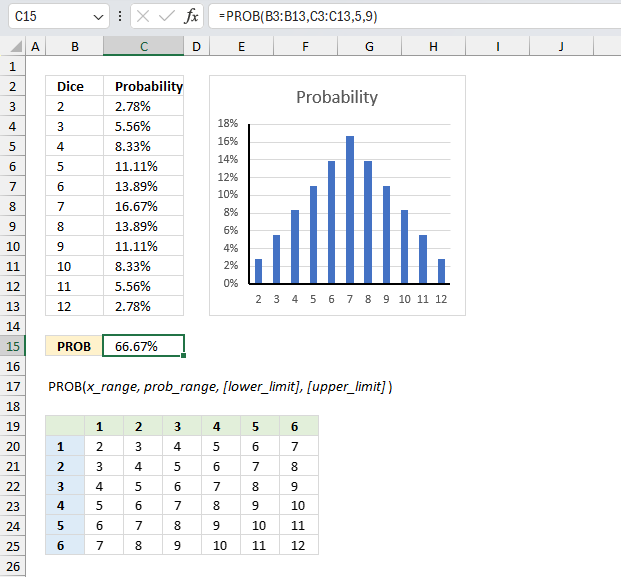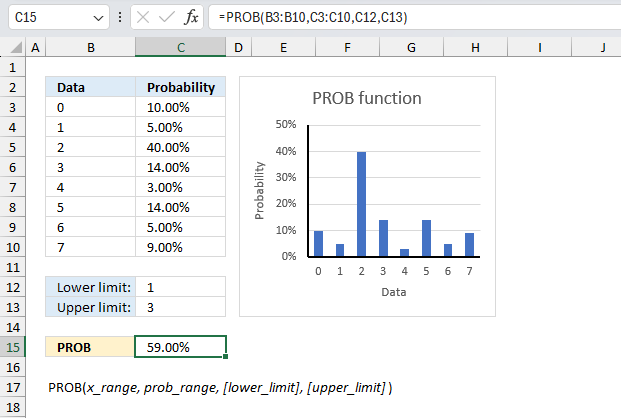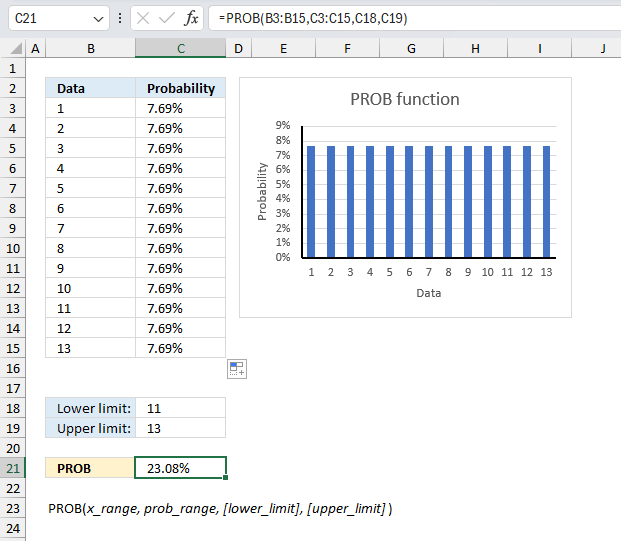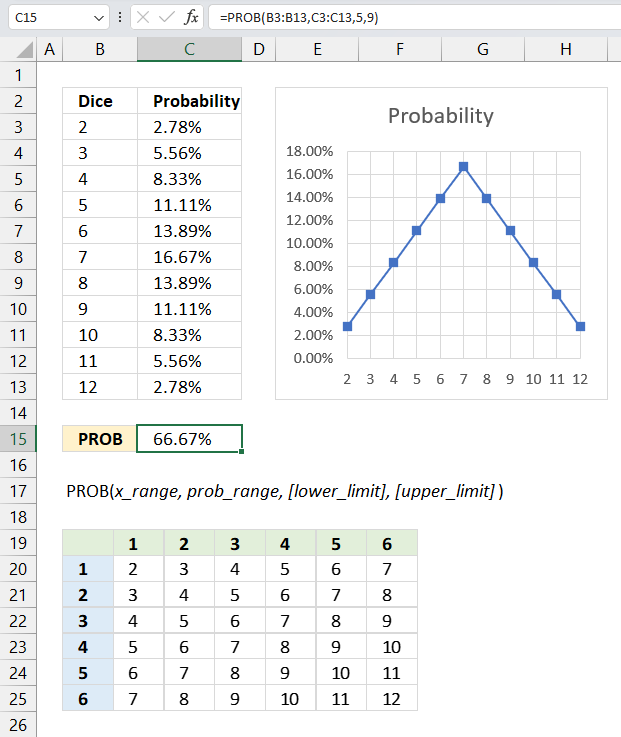How to use the PROB function

What is the PROB function?
The PROB function calculates the probability that values in a range are between a given lower and upper limit.
Table of Contents
1. Introduction
What is probability?
Probability is how likely an event will occur, it quantifies the chance/risk of something happening.
- Probability values range from 0 (impossible) to 1 (certain).
- Probabilities of all possible outcomes sum to 1.
- Probabilities can be expressed as fractions, decimals or percentages.
Fraction example: 1/7
Decimal example: 0.1428
Percentage example: 14.28% - Probability models randomness and uncertainty.
2. Syntax
PROB(x_range, prob_range, [lower_limit], [upper_limit])
| X_range | Required. The bond's settlement date, in other words, the date a buyer purchases a security. |
| Prob_range | Required. The bond's maturity date, in other words, when it expires. |
| Lower_limit | Optional. The lower bound on the range for which you want to know the probability. |
| Upper_limit | Optional. The upper bound on the range for which you want to know the probability. If omitted the PROB function returns the probability of being equal to the lower_limit. |
3. Example 1

Two fair dice are rolled, and the sum of the numbers on the two dice is recorded. What is the probability that the sum of the two dice falls between 5 and 9 (inclusive)?
This example demonstrates how likely it is for two dice to sum up to given outcomes. This example uses two dice with 6 sides numbered from 1 to 6. Each die has 6 possible outcomes: 1, 2, 3, 4, 5, and 6.
To solve this question, we need to consider the possible outcomes when rolling two dice and their respective probabilities. The table in cell range B19:F25 shows the outcome of every possibility.
For example, to get the total two you need the first die to show 1 and the second die also to show 1. The table shows that this outcome is not very likely because only one of 36 outcomes has the sum two.
On the other hand, seven is the most likely outcome because there are six different outcomes with the same total of seven. To calculate the probabilities of each outcome I use this formula in cell C3:
The COUNTIF function counts the number of outcomes based on the corresponding value in cell range B3:B13. It then divides the count by the total number of outcomes which is 36 in this example. We now have a table we can use to calculate the probability of getting a total of 5 (lower limit) up to 9 which is the upper limit.
Formula in cell C15:
The result is a probability of 66.67% of getting a total between 5 and 9 using two dice. The probability of getting:
- 5 is 11.11%
- 6 is 13.89%
- 7 is 16.67%
- 8 is 13.89%
- 9 is 11.11%
The total is 11.11 + 13.89 + 16.67 + 13.89 + 11.11 = 66.67%
4. Example 2

A scientist has observed 8 different events and their corresponding probabilities for them to happen. Here is the data:
| Data | Probability |
| 0 | 10.00% |
| 1 | 5.00% |
| 2 | 40.00% |
| 3 | 14.00% |
| 4 | 3.00% |
| 5 | 14.00% |
| 6 | 5.00% |
| 7 | 9.00% |
What is the probability that event 1 or 2 , or 3 happens?
The events and corresponding probabilities are in cell range B3:C10. The lower limit is specified in cell C12 and the upper limit is in cell C13.
Here are the arguments:
- x_range = B3:B10
- prob_range = C3:C10
- [lower_limit] = 1
- [upper_limit] = 3
Formula in cell C15:
The function returns a probability value of 59%. Event 1 has a probability of 5%, 2 has 40% and 3 has 14%. The total is 5+40+14 = 59%
5. Example 3

What is the probability to draw a jack or a queen or a king from a standard deck of cards (52 cards)?
The total number of possible outcomes (all cards in the deck) is 52. Each card has an equal probability of being drawn (1/52). There are 4 jacks, queens and kings each.
We can use the PROB function to calculate the probability of getting a knight, queen, or king in a single draw from the deck. 11, 12, and 13 represent jacks, queens, and kings respectively, their corresponding probabilities are 7.69%. (4/52)
The arguments are:
- x_range = B3:B15
- prob_range = C3:C15
- [lower_limit] = 11
- [upper_limit] = 13
The formula in cell C21 calculates the likelihood of drawing a face card, specifically a jack, queen, or king, when selecting a single card from a standard deck of playing cards.
Formula in cell C21:
The result is a probability value of 23.08%, 7.69 + 7.69 + 7.69 =23.08%
12/52 = 23.08%
6. Function not working
The PROB function returns
- #NUM! error of if
- a value in Prob_range is equal or smaller than 0 (zero) or larger than 1.
- if the sum in Prob_range is not equal to 1.
- #N/A! error if there are a different number of values in Prob_range and X_range.
6.1 Understanding the error values

When you encounter an error value in a cell a warning symbol appears. Press with mouse on it to see a pop-up menu that lets you get more information about the error.
- The first line describes the error.
- The second line opens a pane that explains the error in greater detail.
- The third line takes you to the "Evaluate Formula" tool, a dialog box appears allowing you to examine the formula in greater detail.
- This line lets you ignore the error value meaning the warning icon disappears, however, the error is still in the cell.
- The fifth line lets you edit the formula in the Formula bar.
- The sixth line opens the Excel settings so you can adjust the Error Checking Options.
Here are a few of the most common Excel errors you may encounter.
- #NULL error - This error occurs most often if you by mistake use a space character in a formula where it shouldn't be. Excel interprets a space character as an intersection operator. If the ranges don't intersect an #NULL error is returned. The #NULL! error occurs when a formula attempts to calculate the intersection of two ranges that do not actually intersect. This can happen when the wrong range operator is used in the formula, or when the intersection operator (represented by a space character) is used between two ranges that do not overlap. To fix this error double check that the ranges referenced in the formula that use the intersection operator actually have cells in common.
- #SPILL error - The #SPILL! error occurs only in version Excel 365 and is caused by a dynamic array being to large, meaning there are cells below and/or to the right that are not empty. This prevents the dynamic array formula expanding into new empty cells.
- #DIV/0 error - This error happens if you try to divide a number by 0 (zero) or a value that equates to zero which is not possible mathematically. Use the "Evaluate formula" tool to pinpoint the exact location in the formula where this error occurs. The "Evaluate formula" tool is located on the "Formulas" tab on the ribbon. Select the cell containing the #DIV/0 error and then press with left mouse button on the "Evaluate formula button".
- #VALUE error - The #VALUE error occurs when a formula has a value that is of the wrong data type. Such as text where a number is expected or when dates are evaluated as text.
- #REF error - The #REF error happens when a cell reference is invalid. This can happen if a cell is deleted that is referenced by a formula.
- #NAME error - The #NAME error happens if you misspelled a function or a named range.
- #NUM error - The #NUM error shows up when you try to use invalid numeric values in formulas, like square root of a negative number.
- #N/A error - The #N/A error happens when a value is not available for a formula or found in a given cell range, for example in the VLOOKUP or MATCH functions.
- #GETTING_DATA error - The #GETTING_DATA error shows while external sources are loading, this can indicate a delay in fetching the data or that the external source is unavailable right now.
6.2 The formula returns an unexpected value

To understand why a formula returns an unexpected value we need to examine the calculations steps in detail. Luckily, Excel has a tool that allows for a more detailed analysis of a formula.
Here is how to troubleshoot a formula:
- Select the cell containing the formula you want to examine in detail.
- Go to tab “Formulas” on the ribbon.
- Press with left mouse button on "Evaluate Formula" button. A dialog box appears.
The formula appears in a white field inside the dialog box. Underlined expressions are calculations being processed in the next step. Italicized expressions are the most recent result. Four buttons at the bottom of the dialog box allows you to evaluate the formula in smaller steps based on intermediate calculations which you control. - Press with left mouse button on the "Evaluate" button located at the bottom of the dialog box to process the underlined expression.
- Repeat press with left mouse button oning the "Evaluate" button until you have seen all calculations step by step. This allows you to examine the formula in greater detail and hopefully find the culprit.
- Press "Close" button to dismiss the dialog box.

There is also another way to debug formulas using the function key F9, demonstrated in the images above. F9 is especially useful if you have a hunch that a specific part of the formula is the issue, this makes it faster than the "Evaluate Formula" tool since you don't need to go through all calculations to find the problem.
- Enter Edit mode: Double-press with left mouse button on the cell or press F2 to enter Edit mode for the formula.
- Select part of the formula: Highlight the specific part of the formula you want to evaluate. You can select and evaluate any part of the formula that could work as a standalone formula.
- Press F9: This will calculate and display the result of just that selected portion.
- Evaluate step-by-step: You can select and evaluate different parts of the formula to see intermediate results.
- Check for errors: This allows you to pinpoint which part of a complex formula may be causing an error.
Tips!
- View actual values: Selecting a cell reference and pressing F9 will show the actual values in those cells.
- Exit safely: Press Esc to exit Edit mode without changing the formula. Don't press Enter, as that would replace the formula part with the calculated value.
- Full recalculation: Pressing F9 outside of Edit mode will recalculate all formulas in the workbook.
Remember to be careful not to accidentally overwrite parts of your formula when using F9. Always exit with Esc rather than Enter to preserve the original formula. However, if you make a mistake overwriting the formula it is not the end of the world. You can “undo” the action by pressing keyboard shortcut keys CTRL + z or pressing the “Undo” button
6.3 Other errors
Floating-point arithmetic may give inaccurate results in Excel - Article
Floating-point errors are usually very small, often beyond the 15th decimal place, and in most cases don't affect calculations significantly.
7. How is the PROB Function calculated?

PROB function calculates the cumulative probability for a distribution by summing the individual probabilities between the limits. The PROB function does this by adding the percentages from the table based on the given lower and upper limits.
P(lower_limit ≤ X ≤ upper_limit)
Where:
P = Probability
X = Random variable
lower_limit = Lower bound
upper_limit = Upper bound
This calculates the cumulative probability of X being between the lower and upper limits.The PROB function implements this by:
Looking up the value (x) in the provided x_range and getting the corresponding probability (p) from the prob_range. Summing all the probability values p where x is between the lower and upper limits.
Mathematically, this is: Σ p(x) for all x where lower_limit ≤ x ≤ upper_limit
Functions in 'Statistical' category
The PROB function function is one of 73 functions in the 'Statistical' category.
How to comment
How to add a formula to your comment
<code>Insert your formula here.</code>
Convert less than and larger than signs
Use html character entities instead of less than and larger than signs.
< becomes < and > becomes >
How to add VBA code to your comment
[vb 1="vbnet" language=","]
Put your VBA code here.
[/vb]
How to add a picture to your comment:
Upload picture to postimage.org or imgur
Paste image link to your comment.
Contact Oscar
You can contact me through this contact form